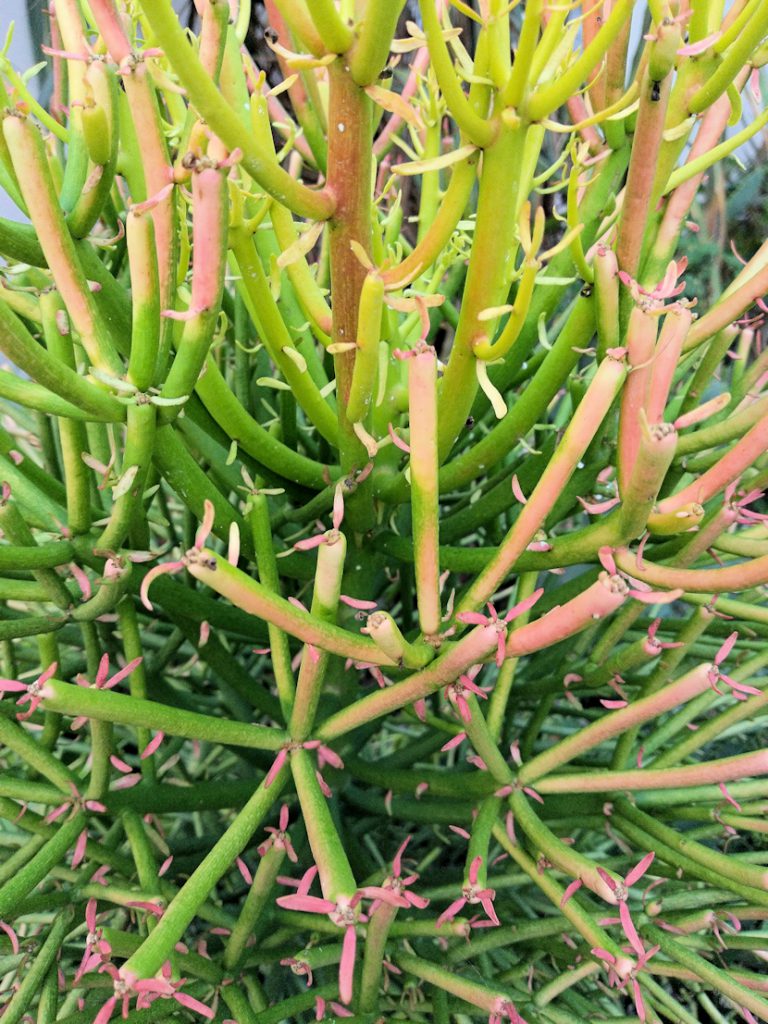
The pencil cactus is a common plant found for sale at garden centers destine for dish gardens and local landscapes. They are succulents and exotic in form and nature with pencil-width stems and tiny leaves. While succulents, they are not really a cactus and are actually close relatives of plants such as the crown of thorns. Their minimalist structure and barebones appearance make for an eye-catching conversation stater. Beyond its interesting growth, it is toxic which will be discussed in detail.
The pencil cactus is in the genus Euphorbia which includes many plants commonly encountered such as the aforementioned crown of thorns. A common feature in this family of plants is a white latex sap that can cause burning and irritation to eyes, skin and mouth resulting in blistering irritation. I have seen several cases where homeowners were not aware of the pencil cactus’s caustic nature and suffered burns to eyes and skin when splashed with the sap during pruning – some resulting in emergency room visits. Pets can also suffer if the cactus winds up in their mouth burning mucous membranes and causing stomach problems including vomiting which may require veterinarian assistance. Bottom-line, a word to the wise is sufficient. Many of our local ornamentals are toxic, and pencil cactus is just another one to be aware of.
Ornamentally speaking, the pencil cactus is a unique plant native to arid areas of Africa. Growing up to twenty-feet tall in nature, most in our area are kept in containers or are part of a succulent collection where it can grow into a small tree-like plant. The leaves are so small on the green succulent stems that the pencil cactus appears leafless. Stems often display orange-colored tips where non-descript tiny flowers can form. With age, the pencil cactus can develop a somewhat woody trunk and stems making it look very tree-like.
Like many succulents, pencil cactus will do best in very well-drained soil. Poorly drained areas will potentially promote root rots to develop. Full, all-day sun is also recommended for vigorous growth and best color. The pencil cactus can freeze, so move specimens under cover if a cold snap is predicted. While pencil cactus can take the seasonal rains of summer, keep this succulent on the drier side during the winter when it is in a somewhat dormant state.
As mentioned above, be careful of the sap. Wear gloves when handling and especially when pruning and propagating. Propagate using six-inch tip cuttings which have been dried to seal off the cut end and prevent rot. Using a clean six-inch pot and pre-moistened sterile potting medium, insert several sealed cuttings. Wait until the soil dries to the touch before the next watering. Cuttings should root within four-weeks.
The pencil cactus makes a beautiful specimen plant and is not a problem species according to the UF/IFAS Assessment of Non-native Plants in Florida’s Natural Areas. While normal precautions must be exercised concerning it’s toxic sap, please consider it as a highly ornamental plant for your collection. For more information on all types of succulents suitable for our area, or to ask a question, please visit https://www.facebook.com/CharlotteMGLifeline/ . Ralph E. Mitchell is the Director/Horticulture Agent for the UF/IFAS Charlotte County Extension Service. He can be reached at 941-764-4344 or ralph.mitchell@charlottecountyfl.gov.
Resources:
Perez, J. (2021) Plant Profile: Pencil Plant. The University of Florida Extension Service, IFAS – Putnam County.
Euphorbia tirucalli (2021) The UF/IFAS Assessment of Non-native Plants in Florida’s Natural Areas. The University of Florida Extension Service, IFAS.
Euphorbia tirucalli – (2021) Wikipedia – https://en.wikipedia.org/wiki/Euphorbia_tirucalli
VanZile, J. (2021) How to Grow the Pencil Cactus. The Spruce. https://www.thespruce.com/grow-pencil-cactus-inside-1902984
Euphorbia (2021) Wikipedia https://en.wikipedia.org/wiki/Euphorbia .
 1
1
